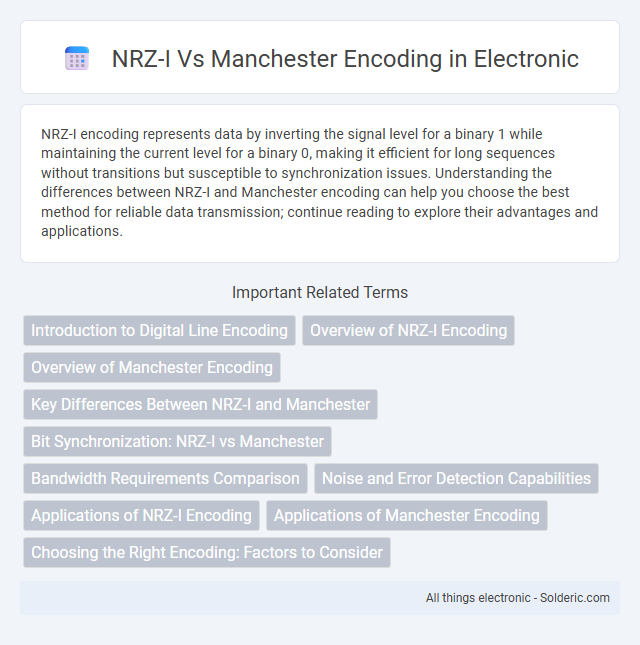NRZ-I encoding represents data by inverting the signal level for a binary 1 while maintaining the current level for a binary 0, making it efficient for long sequences without transitions but susceptible to synchronization issues. Understanding the differences between NRZ-I and Manchester encoding can help you choose the best method for reliable data transmission; continue reading to explore their advantages and applications.
Comparison Table
| Feature | NRZ-I (Non-Return-to-Zero Inverted) | Manchester Encoding |
|---|---|---|
| Signal Representation | Signal inverts on '1', unchanged on '0' | Logical '1' = low to high transition, Logical '0' = high to low transition |
| Clock Synchronization | Relies on signal transitions, weaker synchronization | Embedded clock via guaranteed mid-bit transitions |
| Bandwidth Efficiency | More bandwidth efficient, lower frequency required | Less bandwidth efficient, requires higher frequency |
| DC Component | Possible DC component due to long sequences without transitions | No DC component, balanced signal levels |
| Error Detection | No inherent error detection | Better error detection through transitions |
| Application | Used in magnetic and optical storage, legacy systems | Common in Ethernet, digital communication systems |
Introduction to Digital Line Encoding
NRZ-I (Non-Return-to-Zero-Inverted) and Manchester encoding are fundamental digital line encoding techniques that convert binary data into electrical signals for transmission. NRZ-I changes the signal level only on a binary 1, maintaining the same level for a 0, which helps reduce bandwidth but can cause synchronization issues. Manchester encoding combines clock and data signals by transitioning at the middle of each bit period, providing better synchronization and error detection at the cost of doubled bandwidth requirements.
Overview of NRZ-I Encoding
NRZ-I (Non-Return-to-Zero Inverted) encoding represents binary data by signal transitions at bit boundaries, where a transition indicates a binary '1' and no transition indicates a binary '0.' This method reduces the number of transitions compared to Manchester encoding, improving bandwidth efficiency. Your choice of NRZ-I can enhance synchronization in communication systems by providing clear transition points for clock recovery.
Overview of Manchester Encoding
Manchester encoding combines clock and data signals to ensure synchronization by representing each bit with a transition, typically a low-to-high or high-to-low voltage change within the bit period. This encoding method helps prevent long sequences of constant voltage, reducing timing errors and improving signal integrity in communication systems. Your data transmission benefits from enhanced error detection and simplified clock recovery compared to NRZ-I encoding, which relies on changes only at bit transitions.
Key Differences Between NRZ-I and Manchester
NRZ-I encoding represents data by inverting the signal on a logical '1' and maintaining the current state on a logical '0', while Manchester encoding uses a mid-bit transition to represent both '0' and '1', ensuring synchronization. NRZ-I is bandwidth-efficient but lacks inherent clock recovery, whereas Manchester encoding requires higher bandwidth but provides built-in synchronization due to its frequent transitions. Understanding these differences helps you choose the right encoding for applications demanding either simplicity and bandwidth efficiency or robust timing accuracy.
Bit Synchronization: NRZ-I vs Manchester
NRZ-I encoding provides bit synchronization by detecting signal transitions on ones, allowing the receiver to maintain timing based on changes in the signal level. Manchester encoding inherently embeds clock information by combining data and clock signals into a single self-synchronizing stream through mid-bit transitions, ensuring precise bit synchronization regardless of data patterns. Compared to NRZ-I, Manchester offers more robust synchronization at the cost of doubling the required bandwidth.
Bandwidth Requirements Comparison
NRZ-I encoding requires significantly less bandwidth compared to Manchester encoding due to its simpler signal transitions, as it changes state only on a binary '1', reducing the number of transitions per bit. In contrast, Manchester encoding doubles the bandwidth requirement by encoding each bit with a transition in the middle, effectively transmitting two signal changes per bit. Your choice between NRZ-I and Manchester encoding impacts bandwidth utilization, with NRZ-I favoring bandwidth efficiency and Manchester offering improved synchronization.
Noise and Error Detection Capabilities
NRZ-I encoding is more susceptible to noise due to its reliance on signal transitions for data interpretation, making it harder to detect errors without additional error-checking mechanisms. Manchester encoding inherently provides better noise immunity and error detection by combining clock and data signals, ensuring frequent transitions that help synchronize and identify transmission errors. Your choice of encoding impacts the reliability of data transmission, with Manchester encoding offering enhanced error detection in noisy environments.
Applications of NRZ-I Encoding
NRZ-I encoding is widely used in telecommunications and digital storage systems, where synchronization and error detection are critical, such as in Ethernet and magnetic tape recording. Its simple implementation and robustness against certain types of transmission errors make it suitable for long-distance communication over copper cables and optical fibers. You benefit from NRZ-I encoding in environments where maintaining signal integrity and efficient bandwidth utilization are essential.
Applications of Manchester Encoding
Manchester encoding is widely used in Ethernet communication standards, RFID systems, and digital clocks owing to its self-clocking property and robust synchronization capabilities. It ensures error detection and timing recovery in noisy environments, making it suitable for data transmission over short to medium distances in local area networks (LANs). The inherent signal transitions in Manchester encoding simplify receiver design and improve data integrity in communication protocols.
Choosing the Right Encoding: Factors to Consider
Choosing the right encoding between NRZ-I and Manchester depends on factors such as bandwidth efficiency, synchronization needs, and error resilience. NRZ-I offers better bandwidth efficiency and simpler hardware implementation, making it suitable for long-distance communication where bandwidth is limited. Manchester encoding ensures reliable synchronization with embedded clock signals, ideal for environments prone to timing errors and high noise levels.
NRZ-I vs Manchester encoding Infographic

 solderic.com
solderic.com